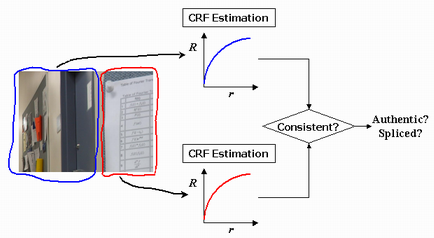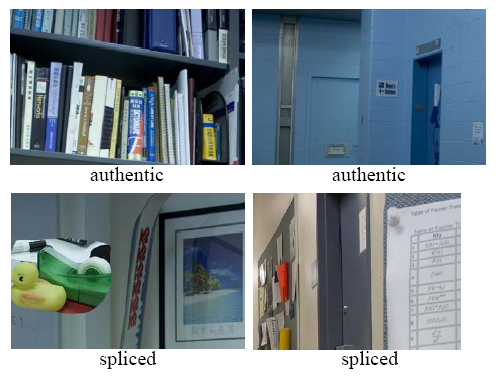
Image Splicing Detection Using Camera Response Function Inconsistency

A spliced image can be detected if individual regions within it have different camera signatures. The nonlinear transform characteristics of irradiance signals, or camera response function (CRF), is used in our consistency checking framework. The test image is first segmented and labeled into suspicious regions. Geometry invariants are extracted and CRF parameters are estimated. A consistency measure is constructed by cross fitting of these GIs and CRFs. We then feed these consistency measures into statistical classification to determine if an image is authentic or spliced. A fairly high detection accuracy of 85.90% can be achieved. With automatic segmentation (which tends to be more inaccurate compared to manual segmentation), we are still able to get 70% precision and 70% recall in detecting spliced images. The classifier also generalizes well to JPEG compressed images that are not in our training or testing set.
Publications
Image Splicing Detection Using Camera Response Function Consistency and Automatic Segmentation
Yu-Feng Hsu, Shih-Fu Chang
International Conference on Multimedia and Expo (ICME), Beijing, China, July 2007. [Abstract][pdf]
@inproceedings{hsu07crfcheck,
author = {Y.-F. Hsu and S.-F. Chang},
title = {Image Splicing Detection Using Camera Response Function Consistency and Automatic Segmentation},
booktitle = {International Conference on Multimedia and Expo},
year = {2007},
location = {Beijing, China}
}
Detecting Image Splicing Using Geometry Invariants And Camera Characteristics Consistency
Yu-Feng Hsu, Shih-Fu Chang International Conference on Multimedia and Expo (ICME), Toronto, Canada, July 2006. [Abstract][pdf][slides]
@inproceedings{hsu06crfcheck,
author = {Y.-F. Hsu and S.-F. Chang},
title = {Detecting Image Splicing Using Geometry Invariants and Camera Characteristics Consistency},
booktitle = {International Conference on Multimedia and Expo},
year = {2006},
location = {Toronto, Canada}
}
Illustrations
Definition of Geometry Invariants
The ratios of partial derivatives of locally planar irradiance points (LPIPs) carry information solely about the CRF but not about irradiance geometry. Therefore they are used to estimate CRF parameters for a single channel image.
CRF Estimation Using Geometry Invariants
All LPIPs yield the same (Q,R) curve, irrespective of plane slope. Non-planar irradiance points give (Q,R) curves with geometry information and are therefore not suitable for CRF estimation.
Consistency Checking by Cross Fitting
The consistency measure is constructed by cross fitting CRFs of one region to (Q,R) samples of another region. Self fitting score of suspicious splicing boundary is expected to carry abnormality of false edges (hence false LPIPs) introduced by splicing.
SVM Classification Result with Manual Segmentation
The classification accuracy is as high as 85.90% with RBF SVM. Note the similar performances in both authentic and spliced categories, stressing the cross-fitting consistency checking is not biased to either case.

Test Images
We use uncompressed images with full EXIF data retained. Spliced images are created by copying regions of authentic images and pasting them onto other authentic images, without post processing. The dataset is available for download as listed below.
Precision-Recall with Automatic Segmentation
All classification results perform better than random guess, as shown in the vertical lines in the figure. Note even with MSRA images, which are JPEG compressed, we are still able to achieve 70% precision with 70% recall (red solid line in (b)). This result demonstrates that our classifier generalizes well to images outside our training set.
JPEG Compressed Test Images
Automatic segmentation gives some partially aligned segments. This figure shows how such segments affect the classification result. Red denotes "wholly aligned correctly classified as spliced", green denotes "partially aligned classified as spliced", and blue denotes "authentic falsely classified as spliced".
It is observed that spliced images with a bulky object, eg. human face or body, are more likely to get both precise segmentation and correct detection ((a) and (d)). Images with similar object and background colors and textures tend to suffer from ineffective segmentation. However in some of these cases the resultant partially-aligned
segments can be of aid ((b) and (e)). Lastly, images with sophisticated textures (eg. grass and tree in (c) and lake reflections in (f)) are prone to false alarms.
References of JPEG Compressed Test Images
[1] Y. Li et al.. Lazy Snapping. Proceedings of SIGGRAPH 2004, pp.303-308.
[2] Y. Li, J. Sun, and H. Y. Shum. Video object cut and paste. In Proceedings of SIGGRAPH, pages 595–600, 2005.
[3] Jian Sun, Weiwei Zhang, Xiaoou Tang and Heung-Yeung Shum. Background Cut. ECCV 2006, Vol. 2, pp. 628-641
[4] J. Sun et al.. Poisson Matting. Proceedings of SIGGRAPH 2004, pp.315-321.
[5] Jian Sun, Yin Li, Sing-Bing Kang and Heung-Yeung Shum. Flash Matting. In Prodeedings of SIGGRAPH 2006.
[6] J. Sun, L. Yuan, J. Jia, H.-Y. Shum. image completion with structure propagation. In Proceedings of SIGGRAPH 2005
[7] Jiaya Jia, Jian Sun, Chi-Keung Tang, and Heung-Yeung Shum, Drag and drop pasting., SIGGRAPH 2006
Links